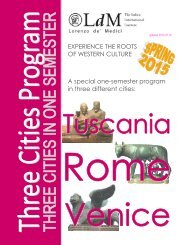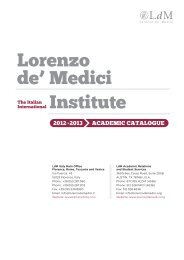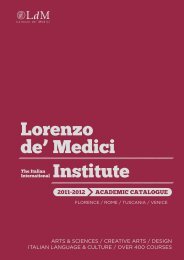aCademiC Catalog 2013-2014 - Lorenzo de Medici
aCademiC Catalog 2013-2014 - Lorenzo de Medici
aCademiC Catalog 2013-2014 - Lorenzo de Medici
You also want an ePaper? Increase the reach of your titles
YUMPU automatically turns print PDFs into web optimized ePapers that Google loves.
School of Creative Arts FLORENCE<br />
Culinary and Nutritional Arts<br />
The Food of Italy<br />
NUH 160 F<br />
Cr: 3; Contact hrs: 45<br />
Although characterized by unique and distinctive features,<br />
Italian cuisine is still perceived as the result of many different<br />
regional culinary traditions that, although merged and diluted<br />
over the centuries, still maintain their particular flavors and<br />
distinct ingredients. The course focuses on the different<br />
aspects of regional food in Italy, from ingredients to recipe<br />
preparation and cooking techniques, with particular attention<br />
to the following factors: historical origins and <strong>de</strong>velopments;<br />
climate and environmental conditions; social issues; food<br />
production; nutrition; and safety and health. Emphasis will be<br />
placed on how food relates to the local lifestyle and culture.<br />
Regional economy and local resources will be analyzed and<br />
compared. Stu<strong>de</strong>nts will be introduced to the various local<br />
products through lectures and class <strong>de</strong>monstrations.<br />
Wine and Culture I: Wines of Italy<br />
NUH 170 F<br />
Cr: 3; Contact hrs: 45<br />
This course investigates Italian wine in the context of the<br />
extraordinary history, philosophy, culture and lifestyle of Italy.<br />
In this context wine is not only a much-loved drink but forms<br />
an essential part of rich cultural traditions extending back to<br />
the Etruscans and ancient Romans. From the study of wine<br />
we learn about the practices of earlier cultures, about their<br />
values and our own, and we gain a unique perspective on<br />
Italy today. The course focuses on the distinct traditions and<br />
economic, geographic and climatic aspects of each area of<br />
Italian wine production. Stu<strong>de</strong>nts explore grape varieties and<br />
different techniques used to make wine, and the national and<br />
regional classifications. They also subject representative wines<br />
to organoleptic analysis (visual, olfactory and gustative). Each<br />
wine is studied in terms of its characteristics, history and<br />
traditions, and in relationship to the particular foods meant to<br />
accompany it.<br />
Wine and Culture II: Wines of Tuscany<br />
NUH 190 F<br />
Cr: 3; Contact hrs: 45<br />
This course <strong>de</strong>als with the different wine areas of Tuscany,<br />
focusing on their distinct historical, traditional, economic<br />
and geographic aspects. Stu<strong>de</strong>nts will be introduced to wine<br />
appreciation by studying the most representative Tuscan wines<br />
and comparing them with famous Italian wines. The major<br />
grape varieties and wine-making techniques will be presented<br />
and each wine will be tasted with a complete organoleptic<br />
analysis: visual, olfactory and gustative. Stu<strong>de</strong>nts will also<br />
learn how to pair wines with food. Specific information on the<br />
marketing of the wine (classification, sale, market) will be also<br />
provi<strong>de</strong>d. During classes stu<strong>de</strong>nts will visit some of the most<br />
famous enoteche in Florence.<br />
Food and Culture<br />
NUH 198 F; Dual listed: ANT 198 F / CLT 198 F<br />
Cr: 3; Contact hrs: 45<br />
If “you are what you eat”, just why do you eat the way you do?<br />
This course consi<strong>de</strong>rs the relationships between the multiple<br />
meanings of food and the acts of preparing and eating food,<br />
and further explores food and personal and social i<strong>de</strong>ntity.<br />
Stu<strong>de</strong>nts will examine why different people make different food<br />
choices in their daily lives, why individuals from certain social<br />
classes will avoid or esteem particular foods, and in general how<br />
food serves as a factor in self-<strong>de</strong>finition. Because a person’s<br />
attitu<strong>de</strong> toward food can reveal not just personal i<strong>de</strong>ntity traits<br />
but a whole food i<strong>de</strong>ology, this course will also analyze the role<br />
of food in the construction of ethnic i<strong>de</strong>ntity, in the display of<br />
religious beliefs, and in the negotiation of gen<strong>de</strong>r roles. Stu<strong>de</strong>nts<br />
learn how cultures and values are transmitted and preserved<br />
through food. Through personal essays and the interdisciplinary<br />
secondary literature, stu<strong>de</strong>nts will be gui<strong>de</strong>d to analyze the<br />
complex and fascinating relationships between people and<br />
food, helping them to un<strong>de</strong>rstand how cultures (including their<br />
own) ultimately <strong>de</strong>termine all human food choices.<br />
Celebrating Italian Style: Food and Culture in<br />
Contemporary Italy<br />
NUH 200 F<br />
Cr: 3; Contact hrs: 45<br />
This course <strong>de</strong>als with the relationships between Italian<br />
traditions, folklore and contemporary Italian society, for example<br />
the links between festivals, food and wines, tourism and today’s<br />
Italian economy. Nowadays the image of Italy in the world is<br />
tightly connected with the global diffusion and promotion of<br />
its leading “Ma<strong>de</strong> in Italy” products, among which food and<br />
wines are the most important. The land of poor emigrants has<br />
become the land of class and style, Italian chefs are as popular<br />
as Italian fashion <strong>de</strong>signers, Italian wines feature among the<br />
best wines of the world, and Italian recipes have found their way<br />
to the world’s most renowned restaurants menus. This course<br />
will give stu<strong>de</strong>nts the opportunity to discover the reasons for<br />
this miracle through a wi<strong>de</strong> range of hands-on cooking lessons,<br />
wine and food tasting, field trips and guest lectures.<br />
Herbs and Spices in Mediterranean Cuisine<br />
NUH 215 F<br />
Cr: 3; Contact hrs: 45<br />
Herbs and spices have played an essential part in the history of<br />
the Mediterranean countries. From their early use in tribal magic<br />
and to cure ailments, they came to be studied systematically<br />
and dispensed by apothecaries and physicians during the<br />
medieval period. Spices arrived from the East brought by the<br />
sea merchants, while the Mediterranean’s natural environment<br />
offered an abundance and variety of herbs. These combined<br />
with the spices were used to preserve and enhance the flavor<br />
of foods. Herbs provi<strong>de</strong> us with many different flavors: from the<br />
<strong>de</strong>licate sweetness of angelica to the sour spiciness of sorrel.<br />
Utilizing them can be simple as chopping up mint for a sauce<br />
and a long drink, or complicated as making one of the herbal<br />
liqueurs composing of dozens different herbs . However you<br />
employ them, herb and spices can impart a tangy flavor to<br />
many meals. Today even the most metropolitan Italians keep<br />
fresh herbs within easy reach by growing them at home in<br />
gar<strong>de</strong>ns or in pots on terraces and in window boxes. Stu<strong>de</strong>nts<br />
will not only learn how to use herbs and spices to zest up the<br />
simplest of dishes, but also as a salt substitute for a healthier<br />
diet. Stu<strong>de</strong>nts will also learn to create and take care of their<br />
own home aromatic herb gar<strong>de</strong>n. During each lesson, besi<strong>de</strong>s<br />
the main topic, specific herbs and spices used in Italian and<br />
Mediterranean cooking will be studied and dishes will be<br />
prepared with them for everyone to taste. Stu<strong>de</strong>nts will be also<br />
given information on a) nutritional profiles, b) how different<br />
herbs and spices affect the body (benefits, adverse effects<br />
etc.), and c) how they can be used as cosmetics, natural<br />
remedies, etc.<br />
Current Trends in Italian Cuisine<br />
NUH 220 F<br />
Cr: 3; Contact hrs: 45<br />
This course explores major trends in contemporary Italian<br />
cuisine that have been emerging in recent <strong>de</strong>ca<strong>de</strong>s. These<br />
trends, revealed in both everyday and haute cuisine, involve<br />
fresh reinterpretations of regional traditions, revaluation of local<br />
products, interest in lighter and healthier diet, and an emphasis<br />
on creativity. Driving these trends are such diverse factors as<br />
interest in other cuisines, innovations by leading chefs, and<br />
especially changes in Italian society and lifestyles. Stu<strong>de</strong>nts<br />
learn basic cooking skills as well as some specialized cooking<br />
methods and techniques. They discover how to select quality<br />
ingredients, and they compare their eating habits with those<br />
common in Italy today. Particular focus is given to the following<br />
aspects: historical origins and <strong>de</strong>velopments of food production,<br />
regional dishes, seasonal and environmental conditions, social<br />
issues, nutrition, safety and health. In each lesson stu<strong>de</strong>nts<br />
learn how to prepare representative recipes, with attention to<br />
ingredients, nutritional values, and presentation.<br />
Current Trends in Italian Cuisine (Vegetarian)<br />
NUH 222 F<br />
Cr: 3; Contact hrs: 45<br />
This course explores major trends in contemporary Italian<br />
cuisine that have been emerging in recent <strong>de</strong>ca<strong>de</strong>s. These<br />
trends, revealed in both everyday and haute cuisine, involve<br />
86<br />
LdM Aca<strong>de</strong>mic <strong>Catalog</strong> <strong>2013</strong>-<strong>2014</strong>





